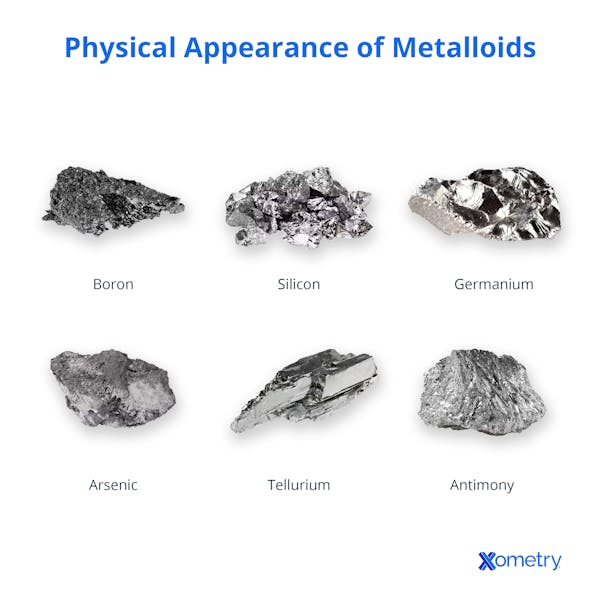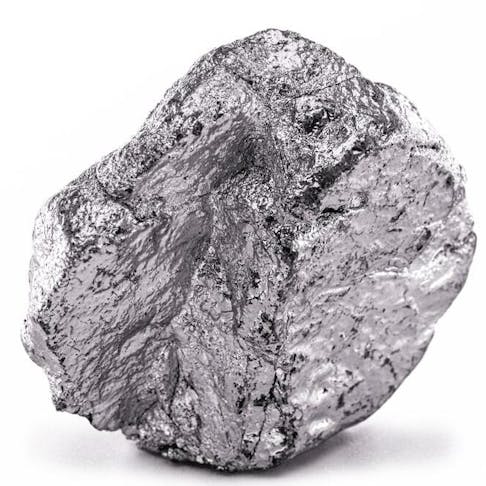The term ‘metalloids” (or “semimetals”) refers to those elements whose properties fall partway between those that are characteristic of metals and those that are characteristic of nonmetals. The exact number of elements that should be considered metalloids is often disputed, but it is generally agreed that there are at least six. The metalloid element antimony was probably the first to come to man's attention. It was used in ancient Egypt in pigments and medicinal preparations.
Metalloids have a metallic appearance and are very hard and brittle. This makes them unsuitable for structural applications in their pure form. However, when metalloids are added to other elements, they help to produce alloys and semiconductors with unique properties that cannot be obtained in any other way.
This article will describe and identify what metalloids are, present their chemical and physical properties, and discuss some typical applications.
What Are Metalloids?
There is no clear and unambiguous metalloid definition. This is because metalloids have properties intermediate between metals and nonmetals. They occupy the line between metals and nonmetals on the periodic table of elements. This often results in disagreement as to which specific elements are metalloids.

Which Elements Are Metalloids?
Depending on how the term is defined, scientists list anywhere from six to nine elements as metalloids. On the periodic table of elements, the metalloids straddle a diagonal line between the metals and nonmetals.
For more information, see our guide on the Elements of Metalloids.
The six elements listed below are universally accepted as metalloids:
- Boron (B): Used to strengthen structural components in automobiles.
- Silicon (Si): The most common semiconductor material.
- Germanium (Ge): Commonly used for semiconductors.
- Arsenic (As): Often used as an insecticide.
- Tellurium (Te): Used as a steel additive to improve machinability.
- Antimony (Sb): Used to color paints and is often alloyed with lead.
Three additional elements are considered metalloids by some scientists. These elements can just as easily be classified as pure metals or nonmetals, hence the ambiguity and disagreement.
- Polonium: Highly radioactive; used as a power source for space probes.
- Astatine: Radioactive element with no current applications outside the research laboratory.
- Bismuth: Used for fire suppression.
When Were Metalloids First Used?
The first metalloid used dates back to ancient Egypt, where antimony was used as makeup and as a colorant for paint and stains. However, it was only classified as a metalloid in the 1500s. Arsenic was also widely used in the middle ages. It was likely first isolated by a German physician, Albertus Magnus, around 1250. Arsenic was widely used as a pigment until it was discovered to be highly toxic. Silicon was first discovered in 1823 by the Swedish chemist Jöns Jacob Berzelius. The first commercially available semiconductors were manufactured in 1954.
What Are the Properties of Metalloids?
Metalloids generally have the physical appearance of metals. They tend to be hard and brittle and behave as semiconductors. Metalloids are also inclined to behave as nonmetals chemically. As such, metalloids aren’t typically used for mechanical applications. However, this behavior depends on the exact elements with which they are reacting. This means in some chemical reactions, metalloids behave as nonmetals and in others, they behave as metals.
For more information, see our guide on the Properties of Metalloids.
What Are Metalloids' Physical Properties?
Metalloids’ physical properties tend to be a mix between those of metals and those of nonmetals. Listed below are some of the physical properties of metalloids:
- Electrical Conductivity: Metalloids do not conduct electricity as well as metals. In fact, many metalloids behave as semiconductors. This means they can be either conductors or insulators, depending on the levels of impurities present, or on temperature effects.
- Physical Form: Metalloids are solid at room temperature.
- Thermal Conductivity: Metalloids conduct heat better than nonmetals, but not as well as metals.
- Density: The densities of metalloids vary widely. For example, silicon’s density is 2.33 g/cm3, while antimony's is 6.69 g/cm3.
- Hardness: Metalloids have a wide range of hardnesses. For example, arsenic has a Mohs hardness of 3.5, while boron has a Mohs hardness of 9.3. For comparison, gold has a Mohs hardness of 2.5, and diamond has a Mohs hardness of 10.
- Mechanical Properties: Metalloids have poor ductility, and as a result are very brittle. Metalloids cannot, therefore, be used in structural applications.
- Metallic Appearance: Most metalloids have an appearance that shows a shiny, reflective surface, similar to that of many metals.
What Are Metalloids' Chemical Properties?
Metalloids will generally have the chemical behavior of nonmetals. Listed below are some common chemical properties of metalloids:
- Electronegativity: Electronegativity refers to how easily an atom will attract elements when forming a chemical bond. The higher the number, the stronger the attraction. Metalloids typically have electronegativity values between 1.8 and 2.2.
- Covalent Bonds: Metalloids will form covalent bonds but do not form monatomic ions as metals do.
- Alloy Formation: Metalloids can be introduced into other metals to form alloys. An example is antimony mixed with lead to form antimonial lead alloys that are used in ammunition.
- Chemical Reactivity: Metalloids tend to form covalent bonds, like nonmetals. They do not typically form monatomic anions, which is a typical metal behavior.
What Are the Applications of Metalloids?
Metalloids are used in a wide range of applications, specifically for their semiconducting properties. Listed below are some examples:
- Semiconductors: Silicon is widely used as a semiconductor and can be found in most electronic devices. Arsenic-doped germanium also has commercially-useful semiconducting properties. Antimony's high charge mobility makes it useful in some specialized semiconductor applications.
- Silicone Rubber: Silicon can be polymerized with oxygen to form a polymer with a silicone-oxygen backbone (polymer branches are typically methyl.) A wide range of properties can be achieved by modifying the polymer chain. Silicone is widely used as a sealant, for lubricants, insulation, and cooking utensils.
- Biological Agents: Most metalloid elements have some medicinal or toxic properties. Arsenic and antimony are classified as toxic. Arsenic was historically used in pesticides, but this application has become less common. Silicon and boron, on the other hand, can have medicinal properties such as antiseptics or oral anti-foaming agents. Boric acid is also used for yeast infections.
- Alloying Elements: Metalloids are often used as metal alloying elements. Examples include silicon in aluminum and boron in iron. Other alloying metalloids include antimony and tellurium.
- Glass: Boron, in the form of borax oxide, is mixed with silicon in the form of silica sand (SiO2) and soda ash to create borosilicate glass. This glass has excellent resistance to thermal shock. Pyrex is popular glass bakeware that is made from borosilicate glass.
Common FAQs on Metalloids
How Many Metalloids Are There on the Periodic Table?
The exact number of metalloid elements on the periodic table is often disputed, with the number identified ranging anywhere from six up to as many as eleven.
Is There a Total of 7 or 8 Metalloids?
Since there is no one definition of metalloids agreed upon by all scientists, there is no real agreement on how many metalloids exist. The most agreed-upon set of metalloids includes boron, silicon, arsenic, germanium, antimony, and tellurium. After these six, there is no agreed-upon final number, and some researchers identify up to 9 or 11 metalloid elements.
Ready to Get a Quote?
Take advantage of our network and see what Xometry can do for you.
Summary
This article discussed metalloids and presented their physical and chemical properties and their uses in industry. To learn more about how metalloids can be used to enhance the performance of other materials and benefit your application, contact a Xometry expert today for assistance.
Xometry provides a wide range of manufacturing capabilities and value-added services for all of your prototyping and production needs. Visit our website to learn more or to request a free, no-obligation quote.
Disclaimer
The content appearing on this webpage is for informational purposes only. Xometry makes no representation or warranty of any kind, be it expressed or implied, as to the accuracy, completeness, or validity of the information. Any performance parameters, geometric tolerances, specific design features, quality and types of materials, or processes should not be inferred to represent what will be delivered by third-party suppliers or manufacturers through Xometry’s network. Buyers seeking quotes for parts are responsible for defining the specific requirements for those parts. Please refer to our terms and conditions for more information.

